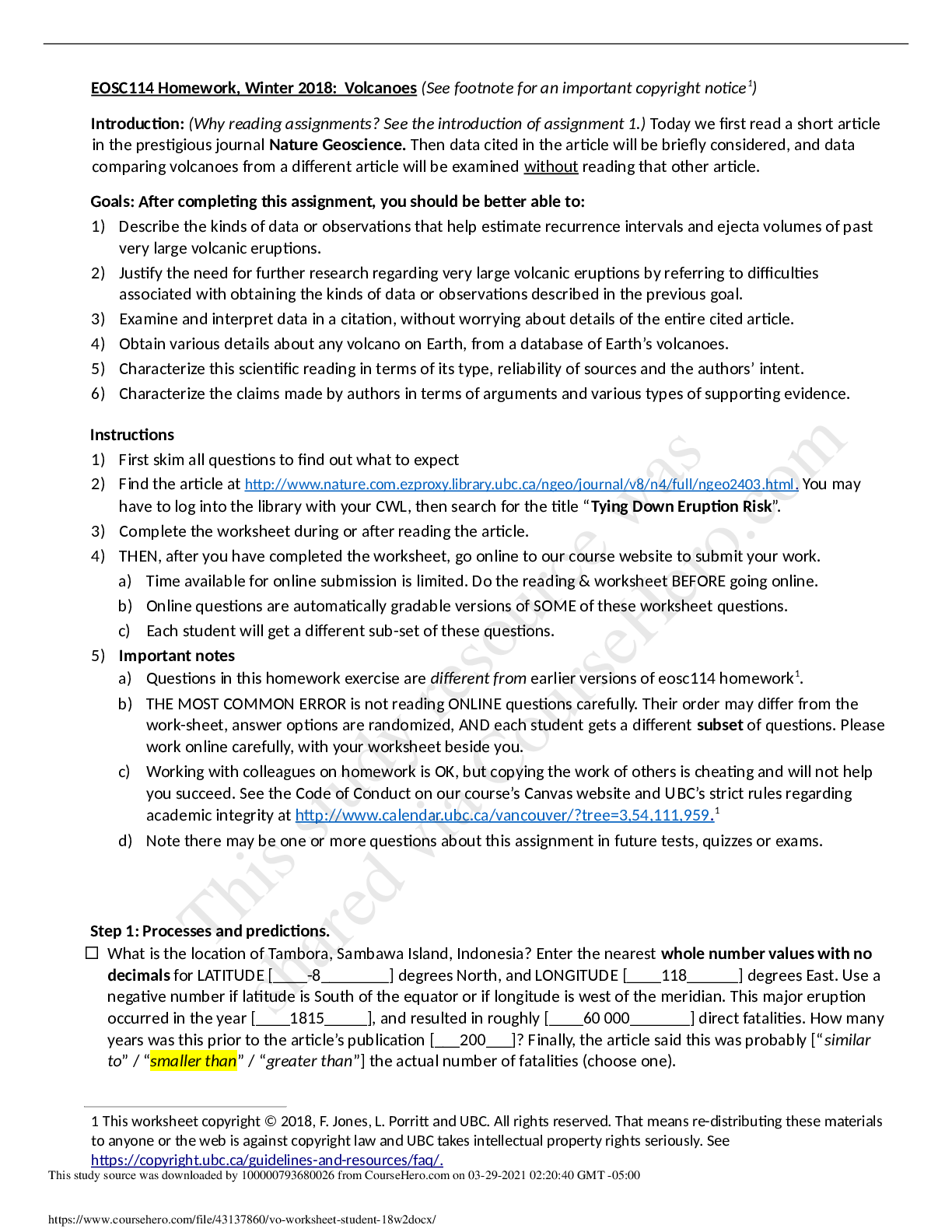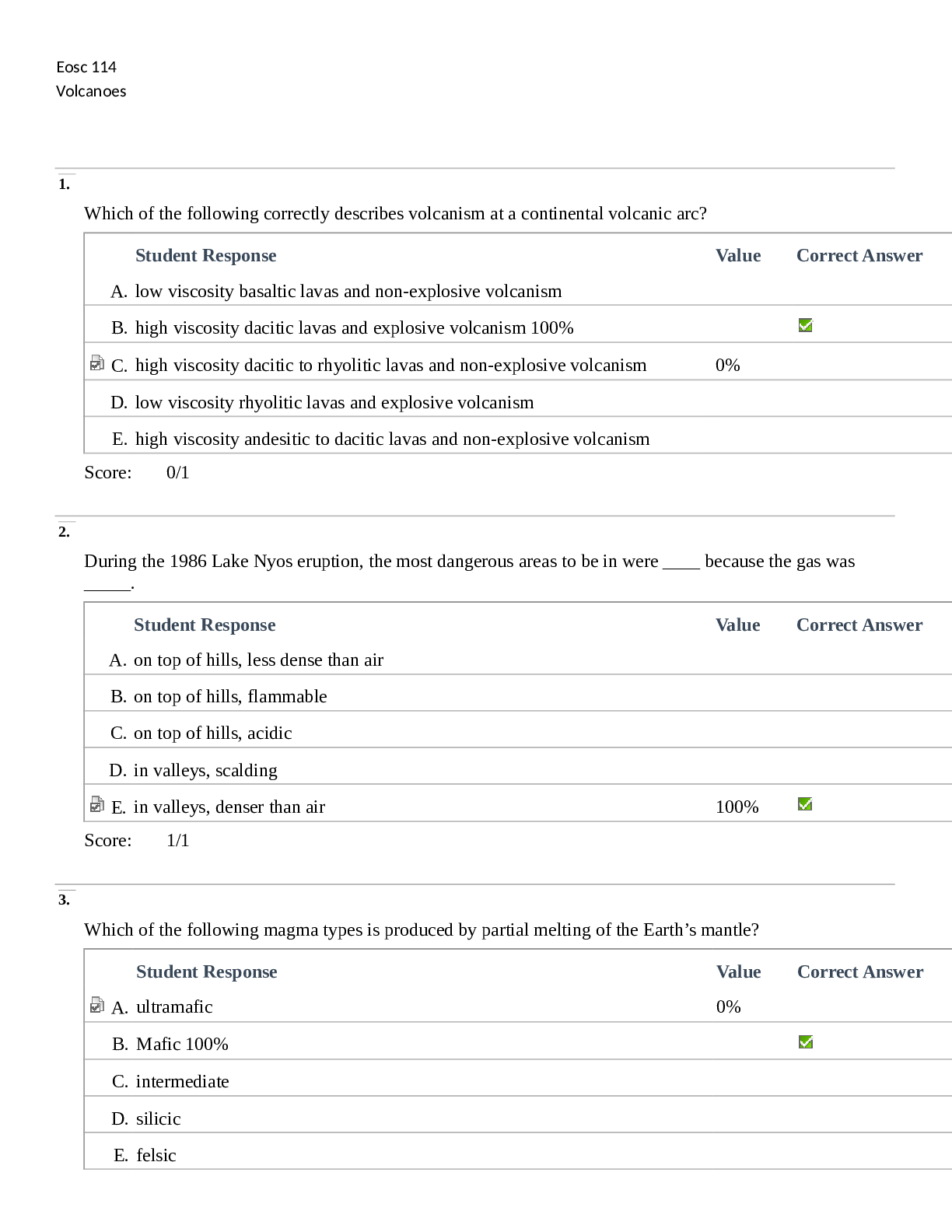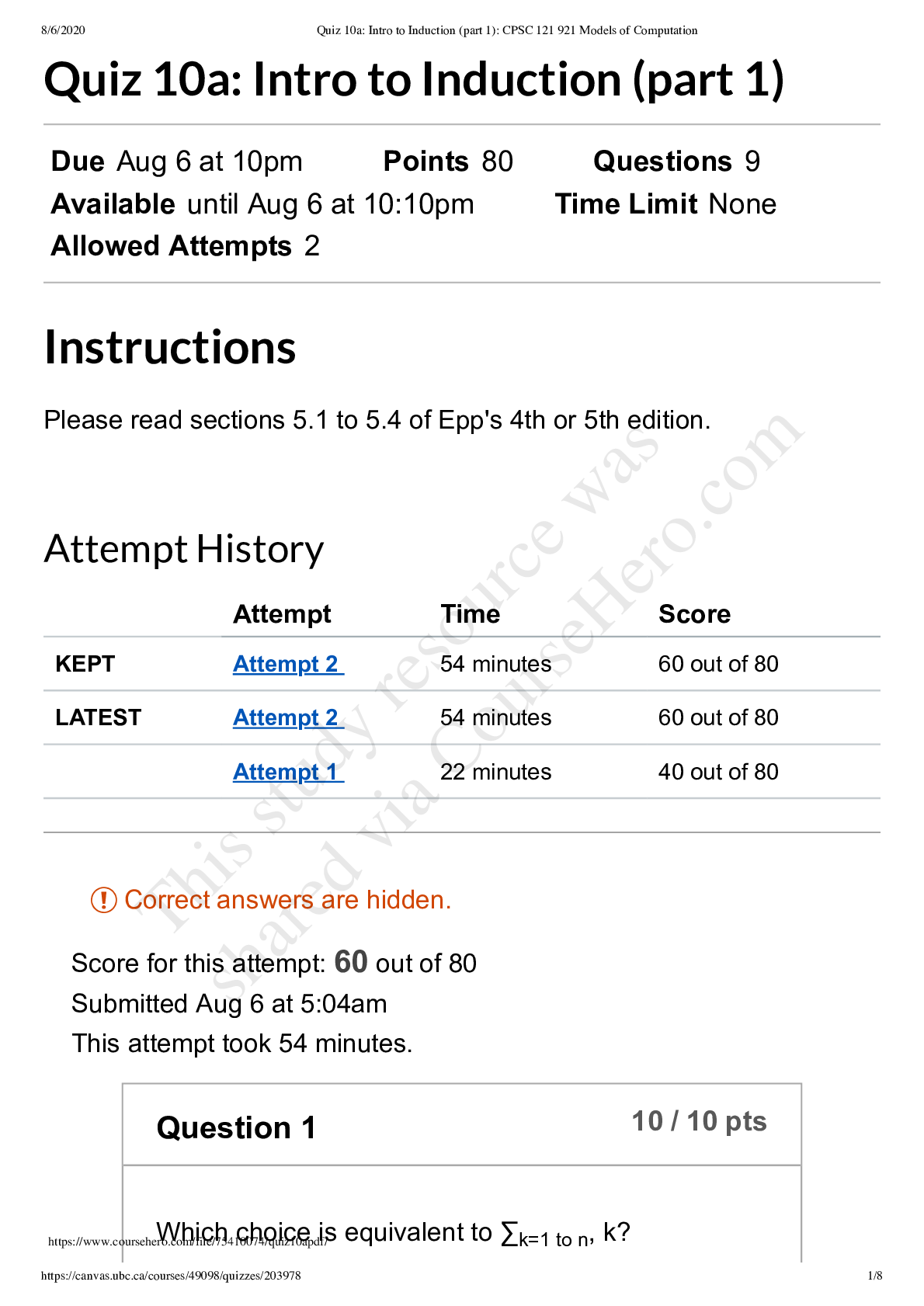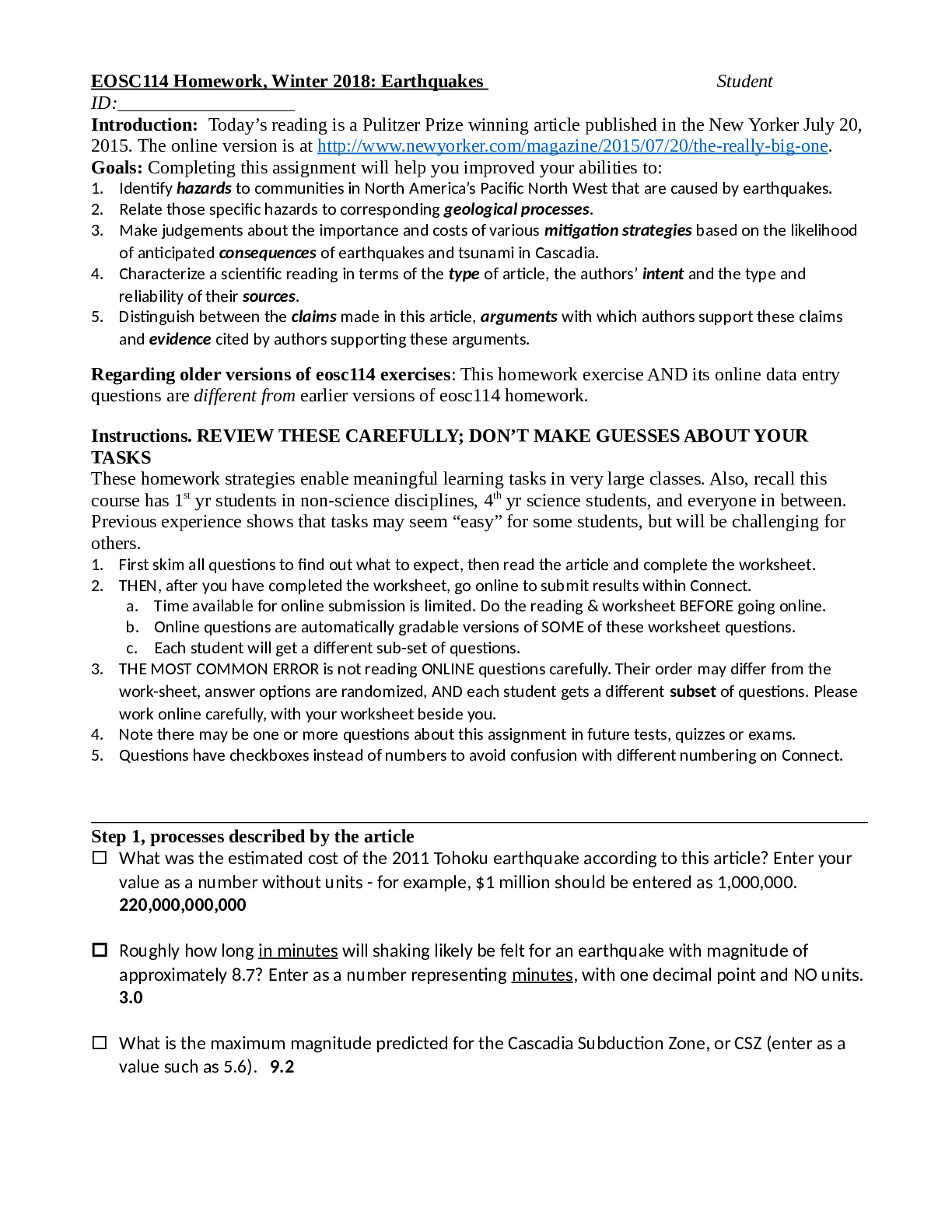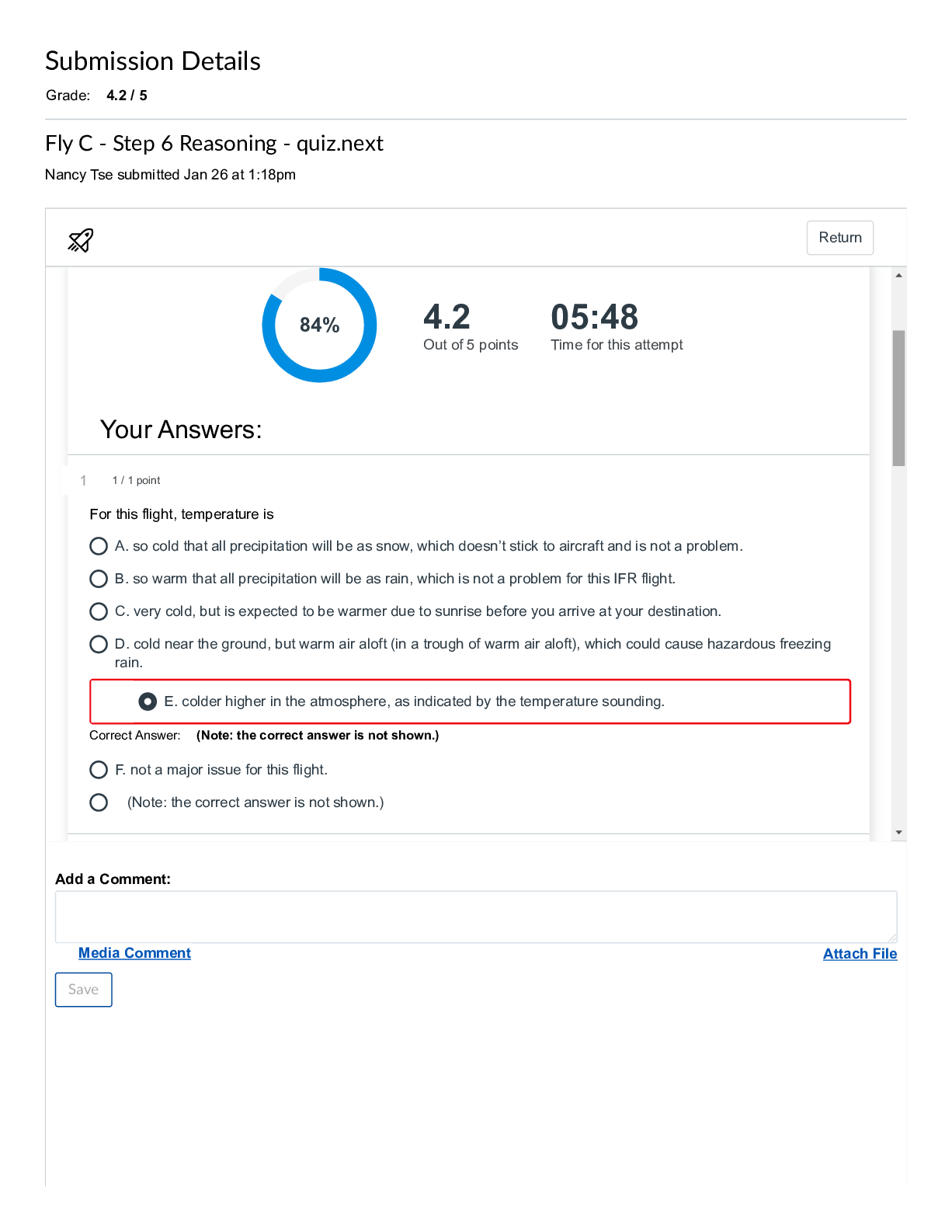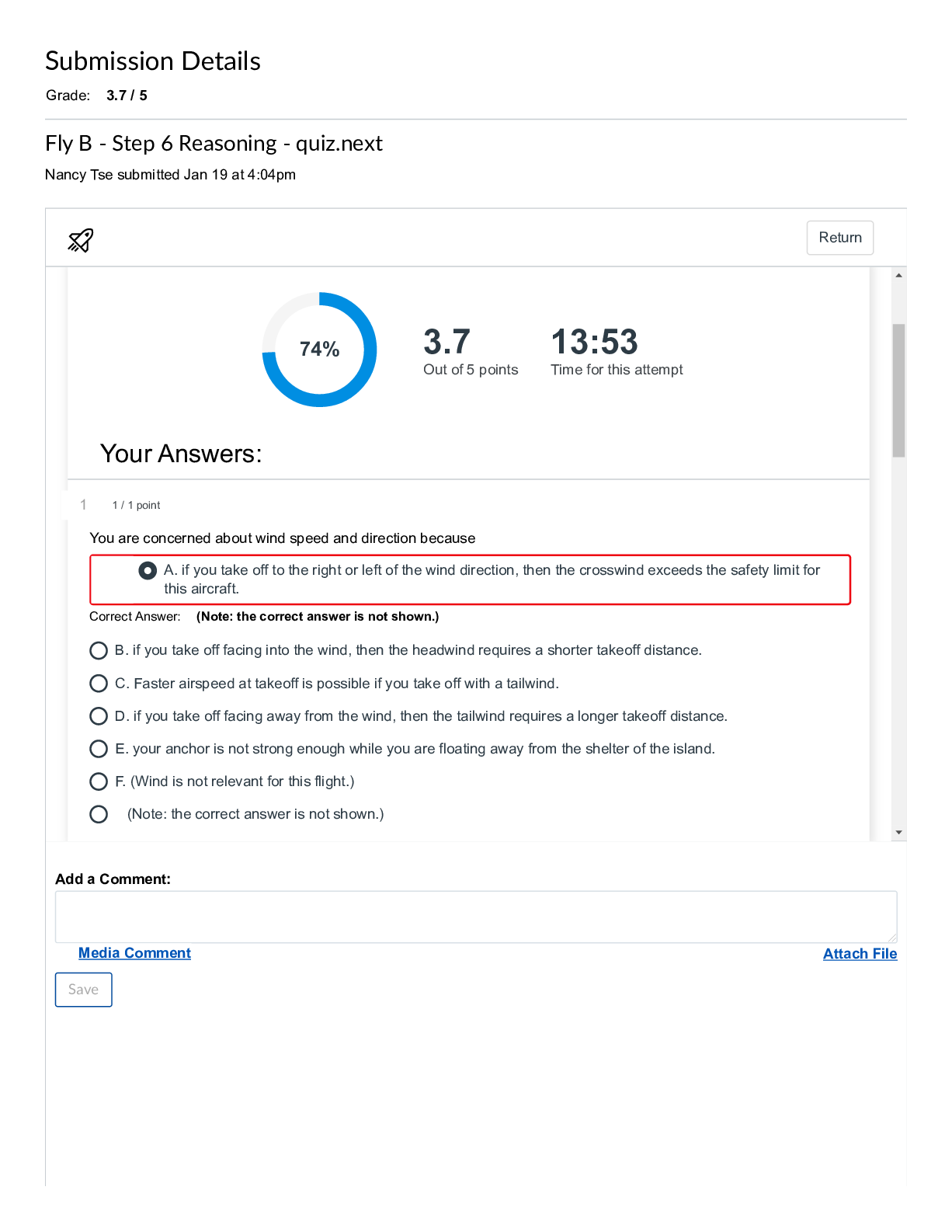Geography > QUESTIONS & ANSWERS > University of British Columbia - EOSC 114 wa-student worksheet18 w2. EOSC114 Homework: Waves and Tsu (All)
University of British Columbia - EOSC 114 wa-student worksheet18 w2. EOSC114 Homework: Waves and Tsunami. This exercise is a mixture of short readings and questions aimed at learning goals in the Waves Module associated with tsunami and shoreline or coastal hazards. Contains Answers too.
Document Content and Description Below
EOSC114 Homework: Waves and Tsunami (See footnote for an important copyright notice ) This exercise is a mixture of short readings and questions aimed at learning goals in the Waves Module ass... ociated with tsunami and shoreline or coastal hazards. After completing the exercise, you should be better able to … 1. Compare levels of risk due to tsunami at Richmond, Vancouver’s north shore and Vancouver Island’s Capital Regional District (CRD) between Port Renfrew, Victoria and eastern Saanich Peninsula. 2. Identify and apply the evidence that lead to those risk-assessment conclusions. 3. Use data summarized in a technical report about potential tsunami effects in the CRD to compare anticipated timing and changes of water levels and flow speeds at several nearby locations. 4. Characterize briefly a fourth style of scientific writing, namely technical reports written by scientists or engineers that were commissioned by decision-makers. 5. Recognize and identify shoreline protection facilities in Google Maps Satellite views, (jetties, breakwaters, groins, seawalls) and longshore drift directions. Instructions: 1. You will need to access web resources including reports, websites and maps. 2. Some references are rather long so we will point you to specific sections of those readings. Citations and access to readings will be provided within the worksheet. 3. As for all other homework, work with this worksheet FIRST. 4. Use two maps at the end of this worksheet to find specific locations referred to in the instructions. If there are other places you do not know, please use maps.google.ca to find out. 5. Working with colleagues on homework is OK, but copying the work of others is cheating and will not help you succeed. See the Code of Conduct on our course’s Canvas website and UBC’s strict rules regarding academic integrity at http://www.calendar.ubc.ca/vancouver/?tree=3,54,111,959.1 Step 1: Some orientation questions based on maps provided at the end of this worksheet and Google Maps. The following distances will help orient you on the map of the area we are studying. To use of google maps “measure distance”, see https://support.google.com/maps/answer/1628031?co=GENIE.Platform%3DDesktop&hl=en. NOTE: Be sure to read distances at the end of Goggle’s distance line, not from numbers in the middle of that line. • Straight line distance along the Strait of Juan de Fuca between the entrance of the Port Renfrew bay (Port San Juan) and the Sooke Harbour entrance. Distance in kilometers (round to nearest km): ____58.88_____km • Straight-line distance between the entrance to Cadboro Bay and just off shore at Sidney. _____23.57____km • Straight-line distance of a helicopter flight between downtown Vancouver and downtown Victoria. ___96.56___km • Find these six places on Map 1 and Map 2 provided below. Rank them in order from 1 = MOST vulnerable to 6 = LEAST vulnerable, should a tsunami arrive from the Pacific Ocean (west of the map). Enter initial guesses first because this will start you thinking about possible affects of tsunami at these locations. We will revisit this question after working through more of this exercise. NOTE: order from MOST=1 to LEAST=6. • Sooke ___3__ • Port San Juan (Renfrew) __2___ • Nanaimo __6___ • Victoria __4___ • Sidney ___5__ • Pachena Beach __1___ (in the Pacific Rim National Park) or Bamfield (a marine sciences centre used by UBC and other researchers and students) Step 2: This section is based on a report prepared for the North Shore Emergency Planning Office in 2005 by Drs. Clague & Orwin of Simon Fraser University: http://nsem.info/sites/default/files/tsunami-hazard-report.pdf. NOTE: this is an excellent example of technical writing prepared by experts for decision makers. It is concise, rigorous and well-referenced, yet highly readable and very well organized. We will identify exactly where to look for answers to these questions, BUT, this report is well worth taking ½ hr to read because it is very consistent with the tsunami and coastline hazards portion of our course. Part 2 is an especially clear background section. • Read the summary page (<5 minutes). Which of these lines of evidence was NOT incorporated into this report? • oral traditions of first nations people of SW. British Columbia • computer simulations of tsunami caused by CSZ (Cascadia Subduction Zone) earthquakes • computer simulations of rock- and land-slides from mountainsides into Howe Sound or Indian Arm • computer simulations of underwater landslides or slumps around the mouth of the Fraser River • Studies of geological sediments that would have been deposited by tsunami • From section 2, which of these factors is NOT a factor contributing to a coastline’s tsunami hazard? • Local topography of the shoreline area • Type of coastline (rocky, sandy, etc.) • Underwater topography just off-shore • Direction of the travelling tsunami wave relative to direction of shoreline • Potential for resonance or amplification within a bay or harbour • Use the google-maps distance-measuring procedure to estimate the distance a boat would travel along the inlet between Bamfield and Port Alberni (not the straight line or “as the crow” flies distance). ___59.8___ km. Read this carefully – previous students made errors by not reading this question carefully. Refer to section 3.1 of the report, and fill blanks with numbers, NOT words. • Due to the Alaska earthquake that occurred in the year_____1964_______, Port Alberni experienced ___3____ (enter how many) waves that arrived, each several hours apart, during the night of March 27th-28th. The first arrived after traveling up the river at _____50_______ km/hr with a maximum wave height of _____3.7_______m above mean sea level. The second arrived less than _____2_______hrs later with a peak wave height that was _____0.6_______m higher than the first. The third was the largest wave but tide had fallen so it’s peak wave height ended up being only _____0.2_______m higher than the first wave. After it was over, _____260_______ homes had been damaged in Port Alberni. • From section 3.2 only: • In January of the year __1700___ a tsunami caused damage at sites up to a maximum wave height of _5__ m., along ___1000__ km of coastline in Japan. This tsunami was later determined to have been caused by a great earthquake of moment magnitude close to _9__, that happened January _26__ at _9__:00 pm, off the Pacific northwest coast of North America. • By studying sedimentary deposits, the 1964 Alaska earthquake was determined to have been (larger/smaller/similar) in magnitude compared to the event of 1700. Next, consider just the 4-item list in section 6.1 which defines the level of “risk” for places close to the shore in terms of elevation above mean sea level (msl). {Hint: challenging. This kind of numerical thinking is not "mathematical", but it does involve thinking quantitatively and logically to make decisions about risk. Discuss / argue with colleagues.} • If you wanted to ensure your new vacation property faced an annual probability of inundation that is less than 0.005 (i.e. 1 in 200), at what minimum elevation above msl should it be built? • 0m (at sea level) • 1.5m above msl • 2.5m above msl • 3m above msl • If you wanted to ensure your new vacation property faced an annual probability of inundation that is less than 0.01 (i.e. 1 in 100), at what minimum elevation above msl should it be built? • 0m (at sea level) • 1.5m above msl • 2.5m above msl • 3m above msl • Section 7 of our reference outlines the risk to North Shore coastal regions from storm waves. Your friend who lives on the south-facing coast of West Vancouver says: “there’s no way our house on the waterfront is in danger. We know waves encountered by friends across the bay in Kitsilano never reached more than 2m height even in the huge storm of December 15, 2006”. What’s your best response to this? (Hint: check your maps to compare locations and orientation of the shorelines at West Vancouver and Kitsilano.) • Your friend is probably right – both shorelines are on the same bay. • Your friend is probably right – the distance that wind can travel over open water for both shorelines is pretty similar for waves coming from any direction. • Your friend is probably right – the difference in near-shore depth patterns likely caused waves at Kitsilano to be larger than you would experience in North Vancouver. • Your friend is probably wrong – the distance that wind can travel over open water for some wind directions will likely result in waves that are larger on the north shore than the south shore of this bay. • Your friend is probably wrong – the shape of the bay will cause all waves along the north side to be larger than the south side. • The main purpose for this reading is to . . . (Hint: consider where or how it was published.) • offer social commentary to any reader. • provide news for the general public. • explain some scientific matters to the general public. • provide information for a person or organization who requested it. • present and discuss recommendations about scientific priorities in the peer-reviewed literature. • communicate new scientific methods, procedures or discoveries to experts in the subject. What writing strategies were used in the portions of this report that we have read? (Online, watch carefully to ensure you are answering each question correctly - they may be offered in a different order.) • Assertions and arguments were supported by scientific observations, measurements or experiments that have already been reported on elsewhere; True / False • Assertions and arguments were supported by new, previously unreported scientific observations, measurements or experiments; True / False • Narrative or personal stories were incorporated into the article; True / False • The author(s) targeted human emotion as part of their writing strategies; True / False • Descriptions of "aesthetic" aspects like scenes, views and impressions were included; True / False • The author(s) identified at least some uncertainties, incomplete aspects or needs for further work; T / F Step 3: Now consider the expected effects of a tsunami for Southern Vancouver Island. To help the communities of southern Vancouver Island make emergency planning decisions, a report was commissioned to estimate the height to which potential tsunami waves could inundate coastal regions. Open the report here and browse the contents. But do NOT read any of the report yet. https://www.crd.bc.ca/docs/default-source/news-pdf/2013/modelling-ofpotential-tsunami-inundation-limits-and-run-up-report-.pdf?sfvrsn=0. • First, this report is structured a little differently from most peer reviewed journal articles. Which section in this report would be UNlikely to occur in a peer reviewed journal article, even if using somewhat different subtitles (Do not read any of the report yet!) • Background • References • Modelling results • Statement of qualifications and limitations • Potential next steps Now read the Executive Summary section only. • The authors chose one out of how many possible 1-in-500-year earthquake scenarios? ___12____ • The computer-based mathematical model used to analyze tsunami behavior and effects was considered the best out of a total of ___8____ competing models that were tested in the year__2009____. • This is the official model used in several places, but which of following does NOT use this model? • Hawaii • American Samoa • Alaska • US Gulf Coast states • A complete and seamless Digital Elevation Model (or DEM) was needed, including above and below sea topography. All of the following challenges had to be overcome except one. Which is the one challenge not mentioned as needing attention before a final DEM could be produced? • Different sources of data having varying accuracies and reliabilities; • Differences between US and Canadian sources, including overlapping data having inconsistent elevations; • Different sources using different datums (i.e. differing definitions of “zero” elevation) • Sections of shoreline not having continuous data • Differences in the definition of “sea level” for different jurisdictions • Based on observations of the tsunami caused by the 2011 Tohoku earthquake, the maximum water level occurring in Japan due to that event was _____11.43_______ times larger than the maximum water level predicted for Greater Victoria in this study. • Emergency planning decisions depend upon several “elevations” or heights, including the following 4 factors. A) The maximum high tide elevation B) The maximum tsunami wave height C) Uncertainties regarding earthquake size, initial tidal conditions and topographic data D) The amount ground will sink in an earthquake The so-called Tsunami Hazard Line is a line representing a certain elevation along the coast. Calculation of this line includes (choose one option only): (Hint: be sure to consider all information surrounding Table ES1.) • Factor A only • The sum of factors A, B and D • Factor B only • The sum of factors B, C and D • The sum of factors A and B • The sum of all 4 factors • The sum of factors A, B and C Consider Table ES1 that summarizes tsunami modelling results. • The largest high-water level will occur at which location? 1. Port Renfrew entrance 2. Sooke Harbour entrance 3. Esquimalt Harbour entrance 4. Victoria Harbour entrance 5. Cadboro Bay 6. Sidney • The longest time before the tsunami first arrives will occur at which location? Same options) • The greatest drop in sea level will occur at which location? (Same options) • The longest time before the highest water level will be experienced at which location? Same options) •) Which three locations will experience variations between high and low water heights of MORE than 3.5 metres? (Why is this important? Because larger hi/lo spans may cause more damage to infrastructure like docks, bridges etc.) • The executive summary ends with suggestions for how the client might use these results. Which one of the following was NOT mentioned as a potential next step? • Planning how to get people out of the area. • Incorporating potential tsunami into a regional plan for responding to emergencies. • Evaluating whether built facilities like docs, breakwaters, roads etc. are adequate. • Determining whether land use or zoning in the region is appropriate. • Setting up contingencies handling transport of goods and people. Now let’s look at just three of the figures generated by the computer modelling done for this report. Do NOT read the whole report – the questions refer to figures only. • Figure 5.1: In areas east of the Cape Flattery, where are maximum water levels expected? Refer to our own map at the end of the worksheet to find Cape Flattery. (Note that the term “maximum water level” is used for the map’s colour scale.) • Middle (not edges) of the Strait of Juan de Fuca between Cape Flattery and Sooke Harbour • Parts of the southern edge of the Strait of Juan de Fuca between Cape Flattery and Sooke Harbour • Parts of the northern edge of the Strait of Juan de Fuca between Cape Flattery and Sooke Harbour • Central region of the Strait of Juan de Fuca south and east of Victoria and Esquimault • Some waterways among islands east of Cadboro Bay and Sidney • Bays and inlets of Esquimalt or Victoria • Figure 5.2: In areas east of Cape Flattery, where is the maximum drawdown of water levels expected? Refer to our own map at the end of the worksheet to find Cape Flattery. (Note that the term “maximum water level” is used for the map’s colour scale, not “wave”.) • Middle (not edges) of the Strait of Juan de Fuca between Cape Flattery and Sooke Harbour • Parts of the southern edge of the Strait of Juan de Fuca between Cape Flattery and Sooke Harbour • Parts of the northern edge of the Strait of Juan de Fuca between Cape Flattery and Sooke Harbour • Central region of the Strait of Juan de Fuca south and east of Victoria and Esquimault • Some waterways among islands east of Cadboro Bay and Sidney • Bays and inlets of Esquimalt or Victoria • Assume Port San Juan (entrance near Port Renfrew) and Sooke Harbour entrance are 58 km apart. Based on this distance and Tsunami Arrival Time data in Table ES1 (considered above), what is the average speed in km/hr of the tsunami wave traveling between these two points? This is just arithmetic but you must be careful with units. Distance is in km. Time difference from Table ES1 is in minutes, and we want wave speed in km/hr. ____139.19______ • How do you expect wave speed to compare to water-flow speed in the center of the Juan de Fuca Strait? The difference is that water-flow speed is the rate at which WATER moves, while tsunami wave speed is the rate at which ENERGY (i.e. the wave crest) moves. • Water speed is much slower than half the wave speed • Water speed is closer to half the wave speed • Water speed is similar to wave speed • Water speed is a little faster than wave speed • Water speed is much faster than wave speed • Figure 6.2 is a satellite photo of Victoria’s harbour with the Tsunami Hazard Line plotted over the image. (NOTE north is to the left and west is down on this photo.) Which of the following regions encompasses the largest area that could experience serious damage, should the event used by this study occur? Again, use our map below to identify named features. • Homes along the north edge of “West Bay” • Docks on the East side of Victoria Harbour’s entrance. • Buildings near the shoreline immediately to the east of the harbor entrance breakwater. • The golf course in the north/west (i.e. lower left) corner of this image. • Homes and parks along the coast immediately west of Victoria’s harbour entrance. What writing strategies were used in the portions of this second report that we have read? (Online, watch carefully to ensure you are answering each question correctly - they may be offered in a different order.) • Assertions and arguments were supported by scientific observations, measurements or experiments that have already been reported on elsewhere; True / False • Assertions and arguments were supported by new, previously unreported scientific observations, measurements or experiments; True / False • Narrative or personal stories were incorporated into the article; True / False • The author(s) targeted human emotion as part of their writing strategies; True / False • Descriptions of "aesthetic" aspects like scenes, views and impressions were included; True / False • The author(s) identified at least some uncertainties, incomplete aspects or needs for further work; True / False • The main purpose for this second reading is to . . . (Consider where or how it was published.) • offer social commentary to any reader. • provide news for the general public. • explain some scientific matters to the general public. • provide information for a person or organization who requested it. • present and discuss recommendations about scientific priorities in the peer-reviewed literature. • communicate new scientific methods, procedures or discoveries to experts in the subject. At this stage, consider revisiting the earlier question about placing different locations in order of vulnerability. Step 4: Consider coast-line protection facilities in use at Victoria, Vancouver or neighboring cities Look at Crescent Beach in White Rock south of Vancouver, using this Google Maps link: https://www.google.ca/maps/@49.0530907,-122.8842827,1670m/data=!3m1!1e3 . You may have to zoom in to examine details, but do not consider coastline outside the region circled on the figure here. (Sediment transport, long shore drift and coastal protection facilities are discussed in class, or starting at http://www.beachapedia.org/Longshore_Sediment_Transport and http://www.beachapedia.org/Shoreline_Structures ) • Along the portion of Crescent Beach circled here, how many breakwaters can you see in use: 1. None 2. 1-2 3. 3-6 4. 7-12 5. 13-20 6. More than 20. • Along the portion of Crescent Beach circled here, how many groins can you see in use? ___5___ Same options • Along the portion of Crescent Beach circled here, how many jetties can you see in use? ___1___ Same options • Along the portion of Crescent Beach circled in the figure, what is the predominant direction that sand moves due to longshore transport? • From east towards the west • From west towards the east • From south towards the north • From north towards the south • The sand does not appear to exhibit longshore drift. • Just north of the circled are of Crescent Beach is “Blackie Spit”. What is the predominant direction that sand moves along the beach at Blackie Spit due to longshore transport? (This tells you something about how the point or “spit” formed.) • From south-east towards the north-west • From south-west towards the north-east • From north-east towards the south-west • From north-west towards the south-east • The sand does not appear to exhibit longshore drift. On the Google Map you have open, explore along the coastline southwards, then eastwards to White Rock. • Along the south-facing White Rock beach, how many breakwaters can you see in use: 1. None 2. 1-2 3. 3-6 4. 7-12 5. 13-20 6. More than 20. • Along the south-facing White Rock beach, how many groins can you see in use? __1____ Same options • Along the south-facing White Rock beach, how many jetties can you see in use? __2____ Same options •Along the south-facing White Rock beach, what is the predominant direction that sand moves due to longshore transport? • From east towards the west • From west towards the east • From south towards the north • From north towards the south • The sand does not appear to exhibit longshore drift. Step 6: feedback 1) What is one question that YOU would like to ask to clarify what you learned in this exercise? _____________________________________________________________________________________ 2) Name one thing that surprised you the most as you carried out this work. _____________________________________________________________________________________ 3) How long did you spend on this entire assignment, from starting to final submission? _______ mins. (Answer in minutes please; so 1.5 hrs would be 90 minutes. And no words please). 4) This assignment increased your knowledge or understanding of what information is needed to establish wellinformed emergency preparedness plans for communities: • Strongly agree • Agree • Neutral • Disagree • Strongly disagree 5) This assignment increased your appreciation for what communities might expect to experience if a tsunami should arrive from the Pacific Ocean at locations of South Western British Columbia (same options)? 6) This assignment increased your appreciation for the processes contributing to storm, tsunami or other wave and erosional coastline hazards (same options)? 7) Have you any comments about how to improve this exercise (same options)? Map 1: used throughout the exercise, derived from Google Maps, with additional annotations for locations and features referenced during this exercise. Red stars * are specific locations discussed or studied in this homework exercise. Map2: The Victoria and Esquimalt harbour regions that are within the box shown on the previous map. Adapted from https://www.esquimalt.ca/sites/default/files/greater_victoria_tsunami_map.pdf Brown shaded regions = Tsunami Planning Zones, 0m - 4m above sea level. Green stippled regions = parks. [Show More]
Last updated: 1 year ago
Preview 1 out of 10 pages
Instant download
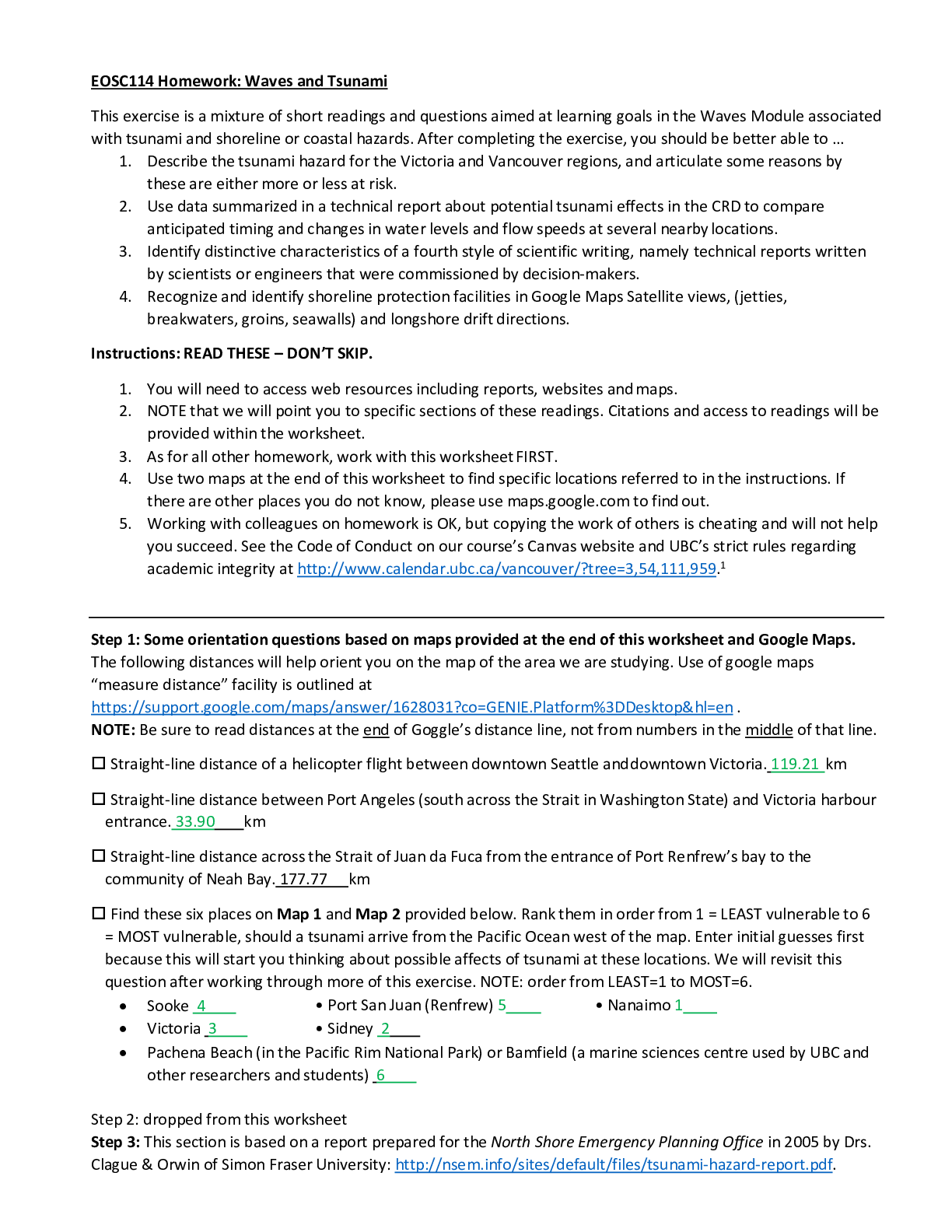
Instant download
Reviews( 0 )
Document information
Connected school, study & course
About the document
Uploaded On
Feb 27, 2021
Number of pages
10
Written in
Additional information
This document has been written for:
Uploaded
Feb 27, 2021
Downloads
0
Views
80




















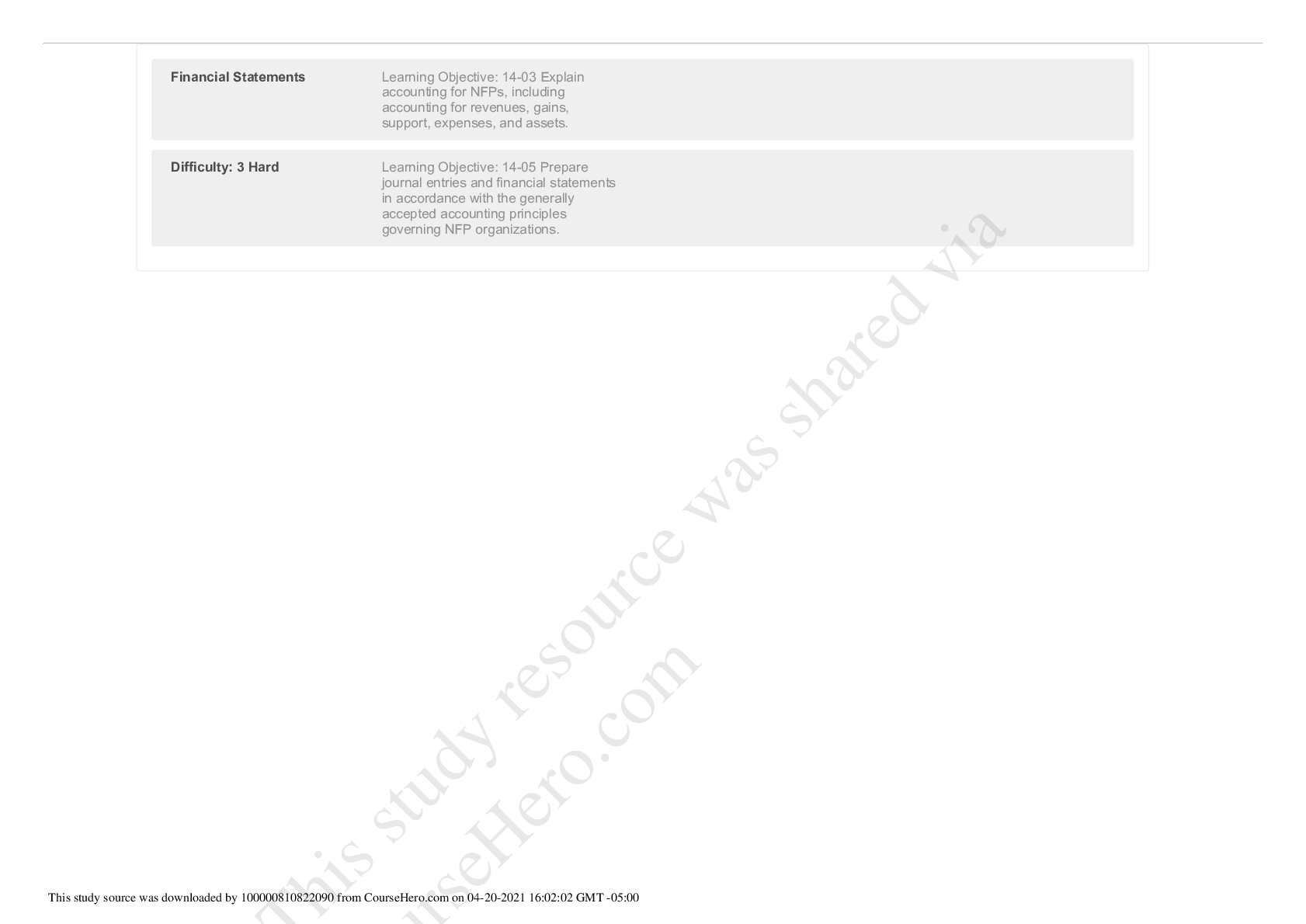
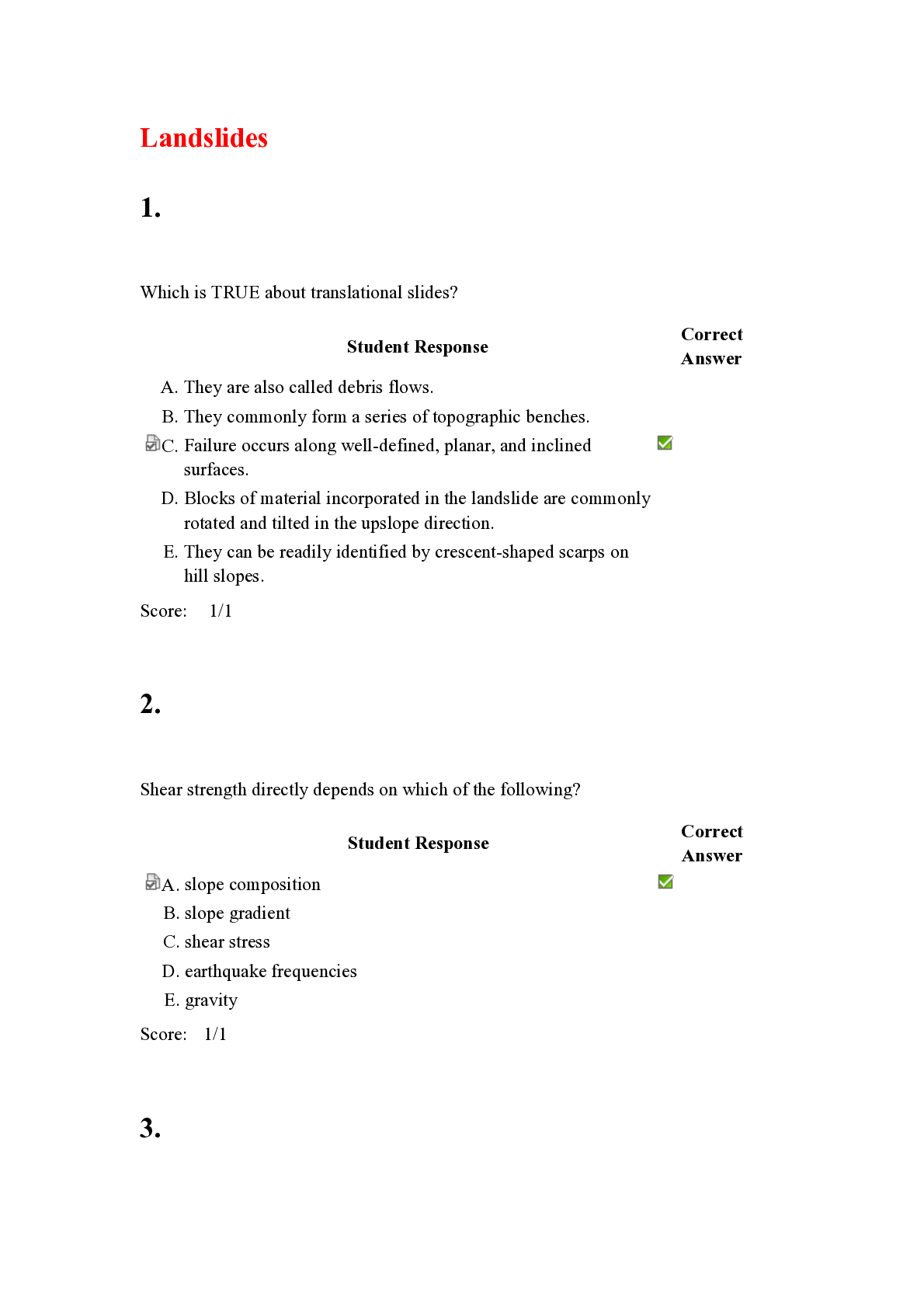


.png)

